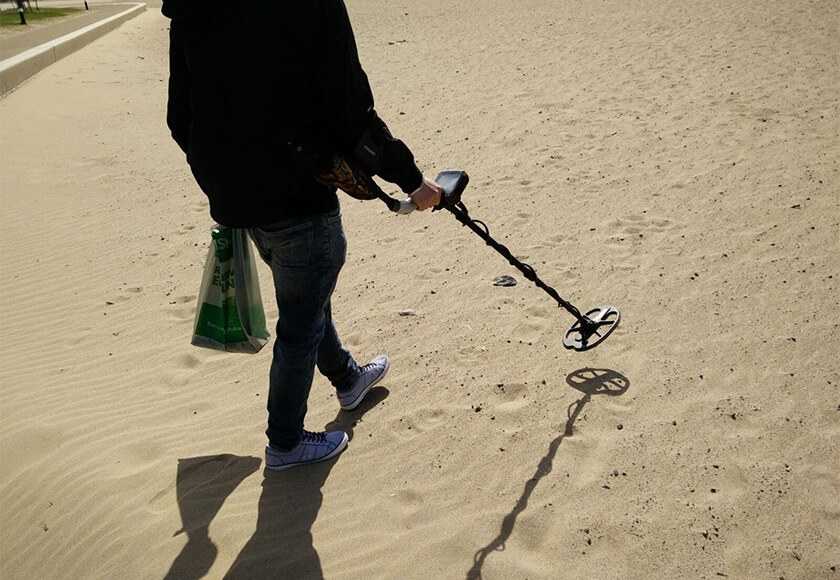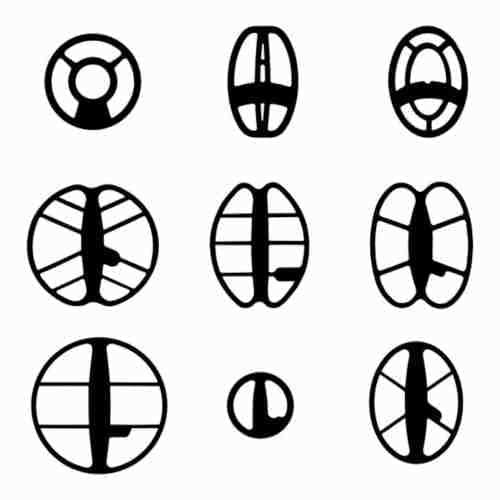
Overview
There are three different types of metal detectors that are available for you to choose from. Before purchasing one, it is absolutely essential that you recognize the variety and differences that are available. You need to select the model that fits best with your budget, your level of expertise, and the type of items you are wanting to explore. After you select a metal detector containing all of the various features that you need, it will help you become more successful in your pursuits.
All metal detectors work on the same basic scientific principal, electromagnetic induction. The detector creates a magnetic field that interacts with metallic objects in the ground. While the basic principle is the same, how the field is created can have an impact on what you will be able to find and where you will be able to find it. They type of metal detector and type of ground can also impact the depth that the metal detector can search to.
back to menu ↑Beat Frequency-Oscillation
This is among the most commonly-used metal detectors. It is the kind that electronic stores mainly carry. It can search for items that are located around two feet underground. These metal detectors use twisted copper that is rolled over a ring made from iron or steel.
These metal detectors have one large ring fastened to the base. There is also another smaller ring that is fastened in a slightly higher location. Both coils are linked to oscillators that produce a frequency.

However, these coils work at different frequencies. This disparity in frequency is received and transmitted by the control box to the speakers. These speakers have a generate a constant hum that is quite noticeable and will be heard by the person using the detector.
Once the base coil has passed over an item made of metal, the interaction of the electromagnetic changes the background hum to a metallic item is present.
back to menu ↑Very Low Frequency
VLF is one of the more widely-used types of detectors since it has a wide range of uses thanks to technological advancements. The detector comes with two spherical wires that are the receiver and transmitter. The transmitter is used for releasing a low-frequency magnetic field into the ground to use for hunting treasures.
Meanwhile, the receiver is used to pick magnetic signals up from an item underneath the ground. These signals are turned into an audible tone as soon as there is a signal.
The type of detector also comes with a tuner, which is a type of electric circuit. It sends signals over to the device’s receiver. For silver and gold prospecting, users are able to filter signals out that are coming from aluminum and steel so they are able to focus on the item that they are seeking.
back to menu ↑Pulse Induction
The pulse induction type of detector is specifically used for looking deep into a surface for treasure, gold, and relics. Large-sized models are used at checkpoints needing security to detect firearms and weapons. For this purpose, a single coil is used and a magnetic field is transmitted into the ground. PI machines are best for highly mineralized soil or salt water.
This type of detector changes modes to help users listen for the type of signal that was discovered and is able to distinguish between sent signals and accidental external signals. This kind of detector also is more expensive compared to many others that are available.
back to menu ↑Industrial
One of the most important uses of metal detectors is for security. The doorframe detector and handheld sensor are the two of the most widely-used types of industrial detectors. This kind of detector is usually found in well-secured airports and buildings.
It works on the same electromagnetism principles as other metal detectors. This type of detector is good at preventing criminals with hidden weapons from entering buildings but is unable to be used for gold and treasuring hunting.
back to menu ↑Search Coils
Search coils are among the most essential parts on a metal detector. They are available in different sizes and shapes, depending on what your specific needs are.
Search coils usually are flat in construction. and in Metal detectors might have a receive coil and transmit coil, although they can possibly have a mono-coil, where a single coil works as receiver and transmitter coil.
The transmit coil, when it is powered, generates a magnetic field within the surrounding area. When there is a metallic item inside of the field, then the magnetic field becomes distorted. That causes the receive coil to sense the distortion and a signal is sent over to the control housing, and the user is alerted that a metallic object is present.
Although this capability is not available with all detectors, some special models do come with a tertiary coil, and that is usually a second receive coil which helps to pinpoint the location of the object that has been detected. There are also some metal detector coils that are able to go even further and can determine an object’s approximate depth, although only one company has this technology currently.
Search coils are varied, with every design providing better performance in certain areas, in addition to the different sizes that offer deeper detection rates along with more ground coverage. It is generally accepted that a search coil’s diameter is an approximation of the detection depth is has for coin-sized objects although this isn’t guaranteed for all situations.
In terms of the size of the coil, a larger coil on a larger diameter search coil offers deeper detection and a larger scanning area. However, due to a less concentrated and larger field, they cannot always detect items that are small, like coins. It may also pose a problem when they are used in areas that large amounts of metals items like trash, since it may be detecting several targets at the same time, which makes it less fun and more laborious to pinpoint one item.
However, a smaller sized coil can find smaller objects since its magnetic field is more concentrated across a smaller area. Using smaller coils is best in areas that have large quantities of metal debris, although more scans will have to done in order to scan the area due to their smaller diameter. However, that can potentially be beneficial, since there is a smaller chance to detect multiple targets at the same time, and it helps to more easily pinpoint the location.
Search coils are not only available in different sizes but also come in a couple of different configurations and shapes that provide various benefits for the specific environments they are used in. An elliptical coil has better maneuverability compared to circular coils, and the narrow width also allows for increased coverage of an area. However, in non-mineralized soil, a circular coil provides more sensitivity, in addition to greater detection depth, making it the shape that is most commonly used. Search coils are also available in a 2-box shape, that is used to detect items that are deeply buried, due to there being a greater distance between the receive and transmit coils.
back to menu ↑5 Different Kinds Of Metal Detector Search Coils

Images of the different types of Metal Detector Search Coils
Concentric Search Coils
This type of search coil is comprised of a receiver coil on the interior and a transmit coil on the exterior, which gives the advantage of these coils being wound as big as possible within the search diameter, which provides the best detection depth, in addition to the biggest detection field. Also, concentric coils offer the most symmetrical field, and that makes it a lot easier to pinpoint items, and is more consistent in identifying targets, which makes it the most versatile and common search coil that is available.
However, it is not a flawless design. It is most susceptible to minerals interfering from the ground, making it a lot less effective in grounds that are heavily mineralized.
Imaging Coil
This is an advanced concentric coil version. It is practically the same thing as the concentric but has a second receive coil that provides additional target information to the detector, for target depth capabilities and true target-sizing.
The detector uses additional information to characterize the target more fully and is even able to differentiate treasure from trash with the same conductivity. This capability, however, is limited to just one company and one kind of detector.
Mono Coils
Concentric coils come in many different forms and use different detecting technology. Pulse Induction machines only use mono coils. The main difference between these two types of coils is that a mono coil has both the receive and transmit coils in the same location, or there is one coil that acts as both the receiver and transmitter. A mono coil’s performance is basically the same as the concentric coil. It provides maximum sensitivity, but in mineralized grounds performance still suffers.
Double D Coils
This type of design is intended for reducing ground interference, to recover lost performance by a concentric coil working in mineralized soil. The name of the design comes from the shape of the two coils, which form a D-shape. A canceling effect is generated by the coils of the unwanted ground signals.
The coil’s positive detection field goes under the design’s center section, from the front to the back; with the other part of the coil producing the canceling, or negative detection field, and that helps with maintaining performance in mineralized ground. However, the design isn’t as sensitive, due to its small positive field, as the same size concentric coil over non-mineralized, normal ground. On the other hand, over mineralized grounds, the design provides much better performance. That is why it is recommended to use the Double D coil in areas with higher than normal mineralization. This includes areas where individuals frequently go to when they are hunting for relics or prospecting.
2-Box Coils
Another coil design is the 2-box design. With this configuration, there is a separation of several feet between the receive and transmit coils. That provides the detector with a design that is more manageable and lightweight and gives the performance of a search coil with a 3-4 foot diameter. The 2-box model is ideal, due to its size, and is frequently used for finding deeply buried object, like relics and caches. Although it can detect larger objects that are deeper underground quite easily, if frequently ignores items that are small, at about 3 inches in diameter.
back to menu ↑How To Avoid Damage to your Search Coils
Given the fact that search coils are essential components used in metal detecting, it is critical that they are kept in the best possible shape, to prevent the coil from being damaged, which may result in performance being impacted, or the coil not working any longer. Although many hunters do have their own personal preferences when it comes to search coil covers, usually it is left up to the person whether they want to use the cover or not. Some people have noticed having a slightly increased depth detection when the cover is not used, while others opt for taking the safe route and potentially sacrificing deeper detection in order to have a coil that is in better shape and lasts longer.
Search Coil Covers
Selecting the right coil cover both keeps the coil clean and protects it. When a cover is used, it prevents rock fragments and dirt from getting inside and disrupting the magnetic field particularly if the direct is mineralized, which may result in false positives being received by the detector, even when it isn’t held over metallic objects. In order to avoid this situation, a sealant should be used to prevent the cover from falling off, and to protect the search coil against dirt, water, and other contaminants while you are hunting for treasure.
back to menu ↑Conclusion
The different kinds of search coil designs for metal detectors have been designs to work in certain environments more optimally. Although some might work sufficiently in other types of environments still, they might not offer the performance that is designed. For instance, a Pulse Induction detector is best for detecting on the beach, since they ignore the minerals that are in the sand, which allows you to focus on the actual items, instead of the “noise” that the minerals create, which can be potentially very frustrating.
There are some entry-level detectors that have presets to negate or minimize the coil from picking minerals up from the ground, which can either cause false positives or make it hard to discern when an object has actually been discovered. Although many of the types and sizes of coils won’t be used by beginners, it is important and helps to be familiar with them at least, for use in the future. Usually, the default search coil that comes with the metal detector will be sufficient for beach searching and simple hobby detecting. However, not all coils are alike or created equal, and they aren’t all designed to be used for all purposes, and may potentially be triggered by mineralized dirt or sand or ignore metallic objects within their field.
Find the right metal detector, then find your treasure.









